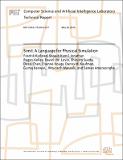Simit: A Language for Physical Simulation
Author(s)
Kjolstad, Fredrik; Kamil, Shoaib; Ragan-Kelley, Jonathan; Levin, David I.W.; Sueda, Shinjiro; Chen, Desai; Vouga, Etienne; Kaufman, Danny M.; Kanwar, Gurtej; Matusik, Wojciech; Amarasinghe, Saman; ... Show more Show less
DownloadMIT-CSAIL-TR-2015-017.pdf (2.160Mb)
Other Contributors
Computer Architecture
Advisor
Saman Amarasinghe
Metadata
Show full item recordAbstract
Using existing programming tools, writing high-performance simulation code is labor intensive and requires sacrificing readability and portability. The alternative is to prototype simulations in a high-level language like Matlab, thereby sacrificing performance. The Matlab programming model naturally describes the behavior of an entire physical system using the language of linear algebra. However, simulations also manipulate individual geometric elements, which are best represented using linked data structures like meshes. Translating between the linked data structures and linear algebra comes at significant cost, both to the programmer and the machine. High-performance implementations avoid the cost by rephrasing the computation in terms of linked or index data structures, leaving the code complicated and monolithic, often increasing its size by an order of magnitude. In this paper, we present Simit, a new language for physical simulations that lets the programmer view the system both as a linked data structure in the form of a hypergraph, and as a set of global vectors, matrices and tensors depending on what is convenient at any given time. Simit provides a novel assembly construct that makes it conceptually easy and computationally efficient to move between the two abstractions. Using the information provided by the assembly construct, the compiler generates efficient in-place computation on the graph. We demonstrate that Simit is easy to use: a Simit program is typically shorter than a Matlab program; that it is high-performance: a Simit program running sequentially on a CPU performs comparably to hand-optimized simulations; and that it is portable: Simit programs can be compiled for GPUs with no change to the program, delivering 5-25x speedups over our optimized CPU code.
Date issued
2015-05-26Series/Report no.
MIT-CSAIL-TR-2015-017
Keywords
Graphs, Matrices, Tensors, Simulation